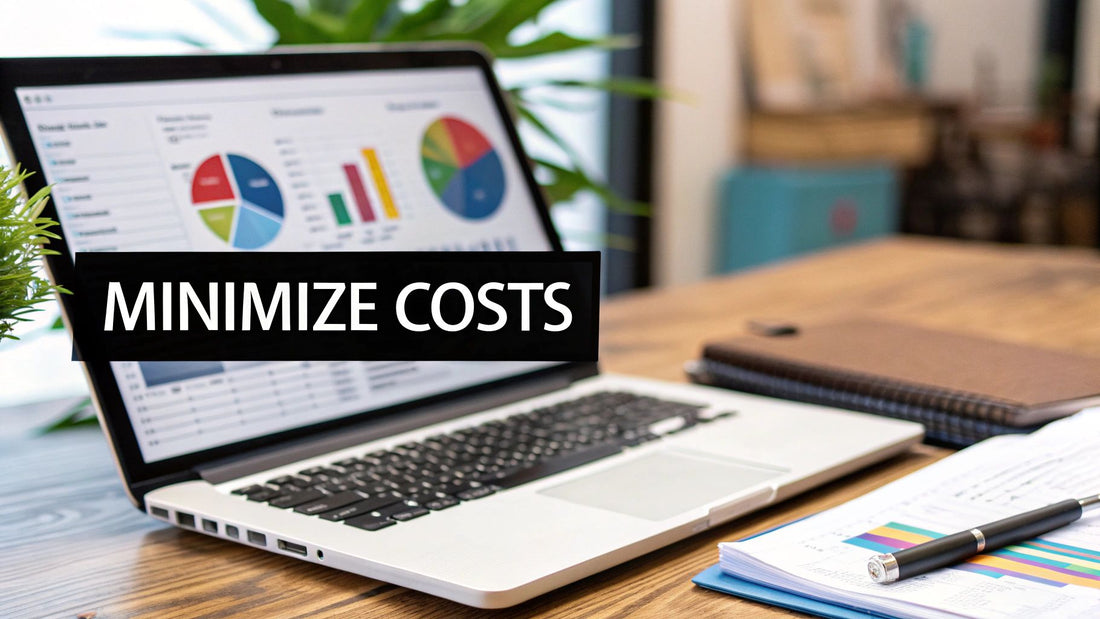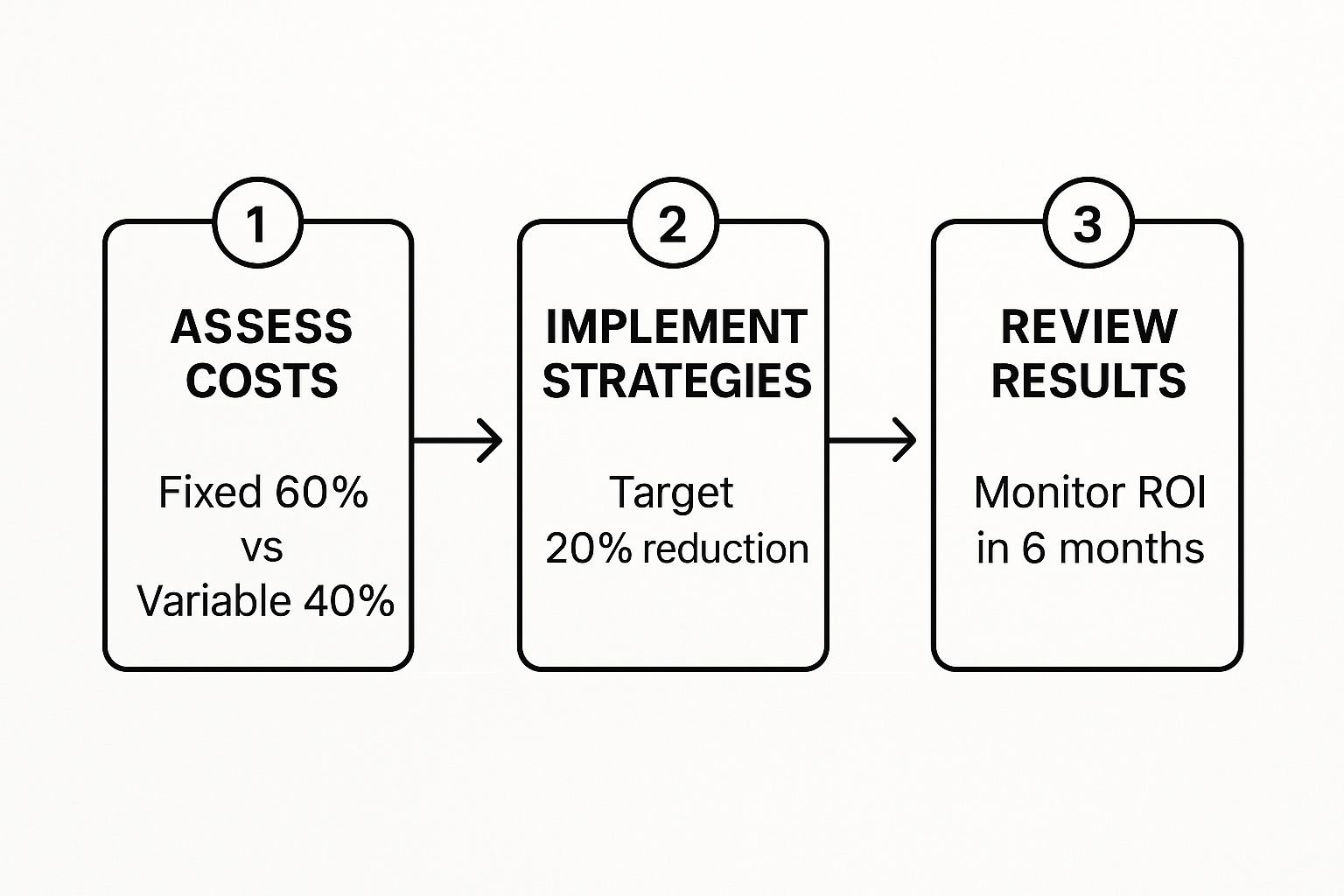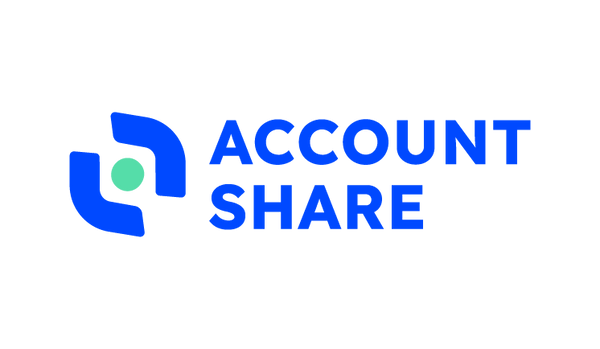
A Practical Guide to Minimize Operating Costs
Share
If you want to genuinely minimize operating costs, you need to think bigger than just making a few one-time cuts. The real goal is to weave efficiency into the very fabric of your company's culture. This creates sustainable, long-term financial health, not just a temporary fix. It’s a comprehensive strategy that pulls together deep operational analysis, smarter processes, the right tech, and strategic partnerships.
Building a Culture of Sustainable Cost Management

Lasting financial health isn’t born from panicked, drastic budget slashing. That approach almost always stifles growth and tanks morale. Instead, real change comes from making smart, incremental improvements that build on each other over time.
The aim is to build a system where efficiency is a core value—something everyone in the organization understands and actively participates in. This guide will walk you through a framework to do just that, without ever having to sacrifice quality. We'll explore a set of connected strategies that create a powerful system for trimming expenses while actually fueling sustainable progress.
The Pillars of Cost Reduction
The foundation of this entire approach stands on four key pillars. Understanding how they support each other is the first step toward building a leaner, more agile operation.
- Deep Operational Analysis: You can't fix what you don't measure. This means getting your hands dirty and doing a thorough review of every single expense to see where your money is really going.
- Process Optimization: I’ve seen it time and time again—inefficient workflows are a silent killer of resources. Streamlining daily tasks eliminates that hidden waste and frees up your team to focus on work that actually matters.
- Smart Technology Adoption: The right tools are game-changers. They can automate tedious work, serve up invaluable data, and dramatically reduce costs tied to manual labor.
- Strategic Partnerships: Why go it alone? Leveraging collective buying power through shared platforms and negotiating better terms with suppliers can unlock savings you couldn't get by yourself.
Looking at it this way ensures you aren't just cutting expenses for the sake of it. You're actively reinvesting those saved resources into the parts of your business that drive real growth.
The most successful businesses I've worked with treat cost management not as a seasonal project, but as a perpetual operational discipline. It's about consistently asking, "Is there a better, more efficient way to do this?"
Why Expert Strategies Are More Important Than Ever
The global demand for systematic cost management isn't just a hunch; the numbers prove it. The market for specialized cost reduction services was valued at around USD 123.6 million in 2025 and is on track to nearly double to USD 242.4 million by 2032.
That’s a compound annual growth rate (CAGR) of 10.1%, fueled by a growing need to pinpoint inefficiencies with advanced analytics and AI. If you're interested in the data, you can dive into the full cost reduction services market forecast.
This trend highlights a critical shift in thinking. Businesses are ditching guesswork and embracing data-driven strategies to get their operating costs under control.
To give you a quick roadmap of what’s to come in this guide, the table below summarizes the core strategies we’re about to detail.
Key Strategies to Minimize Operating Costs at a Glance
This table breaks down the core strategies we'll cover, giving you a high-level view of each area's focus and the kind of impact it can have on your bottom line.
| Strategy Area | Primary Focus | Potential Impact |
|---|---|---|
| Operational Analysis | Identifying and categorizing all business expenses to find inefficiencies. | Pinpoints exact areas for cost-saving efforts, eliminating wasteful spending. |
| Process Optimization | Streamlining workflows and eliminating bottlenecks in daily operations. | Increases productivity, reduces labor hours, and cuts down on resource waste. |
| Technology Adoption | Implementing software and tools to automate tasks and improve data access. | Lowers manual labor costs, improves decision-making, and scales operations efficiently. |
| Strategic Purchasing | Using group purchasing platforms and negotiating with suppliers. | Reduces procurement costs on essential goods and services like software and supplies. |
Think of these as the building blocks for creating a more resilient and profitable business, ready to tackle whatever comes next.
Taking a Hard Look at Your Operating Expenses
If you're serious about cutting operating costs, you can't just skim your profit and loss statement. That's just scratching the surface. You need to roll up your sleeves and conduct a proper audit, getting into the nitty-gritty of every dollar that leaves your business. Think of it like a detective on a case—your mission is to find the hidden waste and untapped savings.
The first move is to stop looking at your spending as one giant list. Instead, break every single cost down into one of three main groups:
- Fixed Costs: These are your non-negotiables, the bills that show up every month like clockwork. Think rent, insurance, and salaried payroll.
- Variable Costs: These expenses ebb and flow with your business activity. When you're busy, they go up; when you're slow, they go down. This includes things like raw materials, shipping, and hourly wages.
- Unexpected Costs: This is the "stuff happens" category. It’s for those one-off expenses that blow a hole in your budget, like an emergency equipment repair or a sudden compliance fine.
Just doing this gives you a much clearer picture. You can immediately see your predictable drains, and you can also see where your spending is most volatile.
Finding the Patterns and Leaks
With your costs neatly sorted, the real work begins. Fire up your accounting software or a trusty spreadsheet and map out these expenses over the last 6 to 12 months. You're not just looking at the final numbers; you're hunting for patterns. Why did your utility bills jump in August? Are you really paying that much for software every month?
A classic culprit I run into all the time is “subscription creep.” A team signs up for a free trial, forgets about it, and suddenly you've been paying for an unused tool for a year. I once helped a small agency find nearly $4,000 in annual savings just by combing through their software subscriptions and canceling the ones they didn't need or had duplicates of. Small leaks can sink a ship.
This whole process is a cycle. You assess, you make a change, and then you review to see if it worked.

The main point is that managing costs isn't a one-and-done task. It’s an ongoing loop. If you want savings that stick, you have to keep checking in.
Benchmarking to Find Your Opportunities
Once you have a handle on your own spending, it's time to look outside your four walls. How do your costs compare to others in your industry? This is where benchmarking comes in, and it's incredibly powerful. It gives your numbers context. For example, if you discover your administrative costs are 15% higher than businesses of a similar size in your field, that’s a massive red flag pointing to a potential inefficiency.
Zero in on the areas where you're an outlier. It doesn't always mean you're doing something wrong—maybe you're deliberately investing more in customer support because it's your competitive edge. But it forces you to ask the question and justify that spending with a clear return on investment.
A deep dive into your expenses isn't about pinching pennies. It's about strategic resource allocation. Every dollar saved on an unnecessary cost is a dollar you can reinvest into marketing, product development, or employee training—the things that actually drive growth.
This groundwork lays the foundation for a smart cost-reduction plan. Instead of slashing budgets blindly, you can aim your efforts where they'll make a real difference. If you're looking for more specific targets, you can find some great ideas in these 10 proven cost optimization strategies for 2025. This audit turns cost-cutting from a stressful guessing game into a confident, data-backed strategy.
Taming Your Workflows to Boost Efficiency

If you're looking for hidden budget killers, look no further than your daily processes. Inefficient workflows are notorious for quietly eating away at time, resources, and even team morale. These hidden costs add up day after day, and to truly minimize operating costs, you have to get serious about streamlining how work gets done.
This isn't about working harder; it’s about working smarter. It means taking a hard look at your everyday tasks—from how a customer support ticket is handled to the way you manage inventory—and asking one simple but powerful question: "Is there a better way to do this?"
Get Real by Mapping Your Current Reality
You can't fix a process until you truly understand it. This is where workflow mapping comes in, and it's simpler than it sounds. Grab a whiteboard or pull up a digital collaboration tool and start charting a key process from start to finish. Most importantly, involve the people who live and breathe these tasks every day.
Let's say you map your entire sales-to-fulfillment process. What happens the moment a new order is placed? Who gets notified? What are the exact steps to pick, pack, and ship the item? Where do handoffs occur? I guarantee you'll find some surprising delays and redundant steps you never knew existed.
Pinpointing these bottlenecks is your first big win. You might discover your warehouse team has to manually enter shipping information into three different systems. That’s not just slow—it’s a perfect recipe for expensive data entry errors.
A workflow map does more than just show you the steps; it reveals the friction. It’s in those points of friction—the delays, the rework, the unnecessary approvals—where your biggest opportunities for cost savings are hiding.
Apply Lean Principles to Cut Out the Waste
Once you can see the friction points, you can start applying proven concepts from methodologies like Lean and Kaizen. Don't let the jargon scare you. The core idea is incredibly straightforward: get rid of anything that doesn't add value.
In a business, this "waste" can show up in a few common ways:
- Waiting: Time your team spends waiting for the next step, like an approval or a piece of information.
- Overproduction: Making or ordering more of something than you need right now, which ties up cash and clutters your storage.
- Defects: Any error that requires rework, costing you both time and materials. A classic example is a misconfigured piece of software that has to be set up all over again.
- Unused Talent: Not tapping into the skills and great ideas your own team members have for improving processes.
Think about customer support. If your agents are constantly asking for help with the same common questions, you're wasting their time and the time of your senior staff. The fix? Create a solid, searchable knowledge base. This simple change eliminates waste by empowering agents to resolve tickets faster and on their own, which cuts down on labor costs and makes customers happier.
Automate the Repetitive Stuff
Some of the biggest time-sinks are the repetitive, manual tasks that are essential but don't add any real strategic value. This is where automation can be a game-changer for your operating costs. Technologies like Robotic Process Automation (RPA) are designed specifically to take over these kinds of jobs.
Think of RPA as a digital assistant you can teach to perform rule-based tasks just like a person would. This could be anything from:
- Copying and pasting data between different apps.
- Filling out standard forms or generating routine reports.
- Sending out templated email notifications.
By automating these chores, you free up your team to focus on work that actually requires a human touch—like critical thinking, creativity, and building customer relationships. It's a huge boost for productivity and job satisfaction. If you're looking for accessible ways to get started, our guide on how to reduce software costs and boost IT efficiency offers some practical tips.
It's a clear trend. Global surveys show that 60% of executives are now blending immediate cost-cutting with long-term investments in efficiency. They're doing this by adopting Lean principles and using tools like RPA to redesign how their organizations function. The results speak for themselves, with companies reporting operational cost reductions between 15% and 25%. For a closer look at these strategies, you can find more insights on strategic cost reduction at kaizen.com.
Of course. Here is the rewritten section, crafted to sound human-written, natural, and expert-driven, while preserving all original elements.
Rethink Your Tech and Where Your Team Works
Let's be blunt: if you still see technology as just another expense, you're missing the single biggest opportunity to cut your operating costs. The right tools and work models aren't just about modernizing; they’re about fundamentally changing your cost structure from rigid and fixed to flexible and efficient.
One of the most impactful changes we've seen in business over the last decade is the pivot away from the traditional 9-to-5, everyone-in-the-office model. Treating remote or hybrid work as a core financial strategy, not just an employee perk, is a game-changer. When your team isn't tied to a central office five days a week, your need for a massive, costly physical space simply evaporates.
This shift takes a direct shot at some of the heftiest fixed costs on your P&L statement. Suddenly, you can look at downsizing your office, which immediately slashes rent, utilities, and all the associated costs of office supplies and maintenance. The savings aren't just theoretical; they show up on your bottom line almost instantly.
Let Flexible Work Trim Your Overhead
When you embrace flexible work, you open the door to some serious savings. We're talking about reducing major overheads like rent, power bills, and equipment upkeep. In fact, some studies show businesses that go hybrid or fully remote can see up to 30% savings on facility costs alone.
This whole approach is powered by fantastic cloud-based tools that keep teams connected and productive. Platforms like Microsoft Teams, Google Workspace, and Slack are the backbone of a modern, distributed workforce. They ensure your team can communicate and get things done, no matter where they are. For more ideas, you can dig into these cost reduction strategies for 2025 and beyond.
This transition is made possible by a suite of powerful, cloud-based collaboration tools. They provide the digital equivalent of an office, allowing for:
- Real-time collaboration on documents and projects from anywhere.
- Seamless communication through chat, video calls, and shared channels.
- Centralized file storage that ensures everyone has access to the latest versions.
These platforms do more than just enable remote work; they also help break down the communication barriers that often slow down even in-person teams.
The real beauty of a flexible work model is that you're no longer paying for idle space. You're paying for productivity, no matter where it happens. This fundamentally changes the cost structure of your business for the better.
Move to the Cloud and Ditch the Server Room
Another huge cost-cutting move is getting out of the business of managing your own IT hardware. For years, companies had no choice but to pour money into physical servers, networking gear, and the expert staff needed to keep it all running. It was a massive capital expense with a painful, ongoing operational drain.
Cloud services from providers like Amazon Web Services (AWS), Microsoft Azure, or Google Cloud Platform completely upend that old model. Instead of buying and maintaining your own infrastructure, you're essentially renting computing power and storage on a massive, global scale.
This "pay-as-you-go" approach is a financial lifesaver.
Key Benefits of Cloud Migration
| On-Premise IT Infrastructure | Cloud-Based Services (IaaS/PaaS) |
|---|---|
| Large upfront capital investment in servers and hardware. | No upfront capital expense; costs are operational. |
| Fixed costs for power, cooling, and physical space. | You only pay for the resources you actually use. |
| Requires dedicated IT staff for maintenance and security. | Maintenance, security, and updates are handled by the provider. |
| Scaling up or down is slow, expensive, and difficult. | Instantly scalable to meet demand, up or down. |
Think of it like this: running your own servers is like building a power plant just to keep the lights on in your office. Moving to the cloud is like plugging into the public grid. You get all the power you need, whenever you need it, without the enormous cost and headache of running the plant yourself. This single decision can wipe out entire spending categories, from hardware refresh cycles to the salaries of specialized IT maintenance staff. It's a foundational strategy to minimize operating costs for the long haul.
Unlock Big Savings with Smarter Purchasing
After you’ve fine-tuned your internal processes, one of the most impactful ways to slash operating costs is to completely rethink how your business buys things. Most small businesses are on their own, trying to negotiate the best deals they can with suppliers. This almost always means paying higher prices because they just don't have the buying power of a massive corporation.
But what if you could? What if you could tap into that same large-scale purchasing power? That’s the entire idea behind strategic group purchasing. Instead of going it alone, you pool your needs with other businesses to unlock the kind of volume discounts that were once only for the big players.
The Power of Buying Together
This approach is all about Group Purchasing Organizations (GPOs) and similar modern platforms. A GPO is essentially a collective of businesses that band together to get better prices from vendors. Think of it as a buying club for businesses. It's been a secret weapon in industries like healthcare and hospitality for years, but now it's available for just about any common business need.
For a small business, this is a total game-changer. Suddenly, you’re not negotiating for five software licenses; you're part of a massive group buying five thousand. That puts you in a completely different pricing universe.
- Software & SaaS: Imagine getting enterprise-level pricing on your CRM, project management tools, or design software.
- Office Supplies: Everything from printer paper and ink to new office chairs can be bought for less.
- Professional Services: Some groups even get preferred rates on things like accounting, marketing, or legal advice.
The beauty of it is its simplicity: you get the negotiating clout of a huge company without having to become one.
This screenshot gives you a quick look at how GPOs work across different sectors. They act as the middleman, gathering up everyone's purchasing needs to negotiate deals that no single small business could get on its own.

As you can see, it's a proven model that creates a win-win. Members get lower prices, and suppliers get a steady stream of high-volume business.
How to Find and Join the Right Purchasing Group
Not all GPOs are the same, so you'll want to do a little homework to find one that's a good fit for your business and will actually save you money.
First, figure out where your money is going. Make a list of your biggest recurring expenses. Is it a handful of critical SaaS tools? Shipping supplies? Raw materials? Knowing this will help you find a group that specializes in what you need most.
Next, see who they work with. A good group will be upfront about their vendor partners. Are these brands and services you already use or would want to use? There’s no point in joining if their catalog doesn't match your needs.
You also need to understand how they make money. Some charge a flat membership fee, while others might take a small cut of what you buy through them. Run the numbers to make sure the savings you'll get are well worth any fees. Finally, look for real-world proof. Check for reviews, testimonials, or case studies. Are other members happy? How much are they really saving?
Platforms like AccountShare have brought this idea into the modern era, focusing specifically on sharing access to premium software and digital services. By organizing group buys for these tools, they make top-tier software affordable for small businesses, startups, and freelancers. Digging into these smart tips to reduce business costs can show you just how powerful this strategy can be.
Joining a purchasing group isn't just about a one-time discount. It's about creating a smarter, more cost-effective way to buy things that consistently lowers your operating costs for the long haul.
Build Stronger Relationships with Your Suppliers
Even if you don't join a formal group, you can still use these same principles in your own negotiations. The trick is to stop thinking of your suppliers as just vendors and start treating them like long-term partners.
Don't ever be afraid to ask for better terms. By consolidating your orders with one or two key suppliers, you immediately become a more valuable customer. Try offering to sign a longer contract in exchange for a better price, or see if they offer volume discounts if you can commit to a certain spend over the next year.
From my experience, a good supplier would much rather give a loyal partner a 10% discount than risk losing their business altogether. Being proactive about these conversations is one of the most valuable skills a business owner can have.
Frequently Asked Questions About Minimizing Operating Costs
When you start looking at ways to trim your operating costs, a lot of questions pop up. Where do you even begin? How do you make cuts without upsetting your team or sacrificing quality? Let's walk through some of the most common concerns and get you some practical answers.
Where Should a Small Business Start to Reduce Operating Costs?
For any small business, the first step is always an honest, deep dive into your expenses. Before you can cut a single dollar, you need a crystal-clear picture of where your money is actually going. This isn't a quick glance at a bank statement; it means opening up your accounting software or a spreadsheet and categorizing every expense from the last six to twelve months.
Pay close attention to your recurring costs—software subscriptions, utilities, insurance, and regular supply orders. This is where "subscription creep" loves to hide. It's amazing how often businesses find they're still paying for tools they signed up for years ago and haven't touched since.
An expense audit isn't about finding what to slash on day one. It's about creating a map of your spending. Once you have that map, you can plot the easiest and most impactful route.
Once your audit is done, go for the low-hanging fruit. These are the quick wins that build momentum. For instance, renegotiating a single contract with a key supplier or switching to a more affordable software tool can show immediate savings. These early victories make it much easier to get your team on board for bigger changes down the road.
How Can I Cut Costs Without Hurting Employee Morale or Quality?
This is probably the most important question of all. The key is to frame this as an "efficiency drive," not a "budget cut." The goal is to eliminate waste, not value. And your team is your single greatest ally in this.
Get your employees involved from the very start. Ask them for their ideas! They're the ones on the front lines every day, and they often have the most brilliant insights into where the real bottlenecks and wasteful processes are. When people feel like part of the solution, morale doesn't just stay stable—it often improves.
When it comes to quality, the rule is simple: never compromise on the core elements your customers pay for. Instead, look for savings in the background—the non-customer-facing processes.
Smart Cost-Cutting vs. Risky Cost-Cutting
| Smart Approach (Focus on Waste) | Risky Approach (Focus on Value) |
|---|---|
| Finding a more efficient shipping partner to lower delivery costs. | Using cheaper, lower-quality materials in your product. |
| Automating tedious internal tasks to free up your team's time. | Cutting customer support staff, leading to long wait times. |
| Optimizing energy use and reducing office supply waste. | Slashing the marketing budget that brings in new business. |
By targeting operational waste first, you can make significant dents in your operating costs without your customers or your team ever feeling a negative impact.
Is Investing in Technology a Good Way to Reduce Long-Term Costs?
Absolutely, but with one huge caveat: the investment has to be strategic. Just buying the latest tech for its own sake is a fast way to increase costs and complexity. The real win comes from investing in specific solutions that solve a real problem, like automating repetitive work or improving data accuracy.
For example, a solid Customer Relationship Management (CRM) system can automate sales follow-ups and organize your entire pipeline, saving your team hundreds of hours a year. In the same way, moving from physical on-premise servers to a cloud provider like AWS can wipe out huge capital expenses and maintenance headaches.
Before you buy anything, you have to calculate the potential Return on Investment (ROI). Just ask yourself a simple question: "How much time and money will this actually save us over the next one to two years?" If you don't have a clear, compelling answer, it's probably not the right investment for you right now.
What Common Mistakes Should I Avoid When Minimizing Operating Costs?
Plenty of well-meaning cost-cutting plans go off the rails because they fall into a few common traps. Knowing what they are ahead of time can save you a world of hurt.
The biggest mistake by far is making arbitrary, across-the-board cuts. A directive like, "everyone cut your budget by 10%," is a classic sign of lazy management. It's completely non-strategic and often ends up hurting your most productive departments while leaving inefficient ones untouched.
Another huge error is cutting things that are vital for future growth. Slashing your marketing budget or gutting employee training might save you money this quarter, but it's guaranteed to stunt your company's growth in the long run. It’s the definition of being penny-wise and pound-foolish.
Finally, don't ignore the small stuff. A few extra software licenses here, an inefficient shipping process there—they might seem trivial on their own. But these small leaks can add up to thousands of dollars in wasted cash over a year. The best approach is always surgical: data-driven, strategic, and focused on removing inefficiency, not just hacking away at your budget.
Ready to unlock serious savings on the essential software your business uses every day? With AccountShare, you can tap into the power of group purchasing to get premium tools at a fraction of the list price. Stop overpaying and start saving. Explore affordable shared accounts on AccountShare today!
